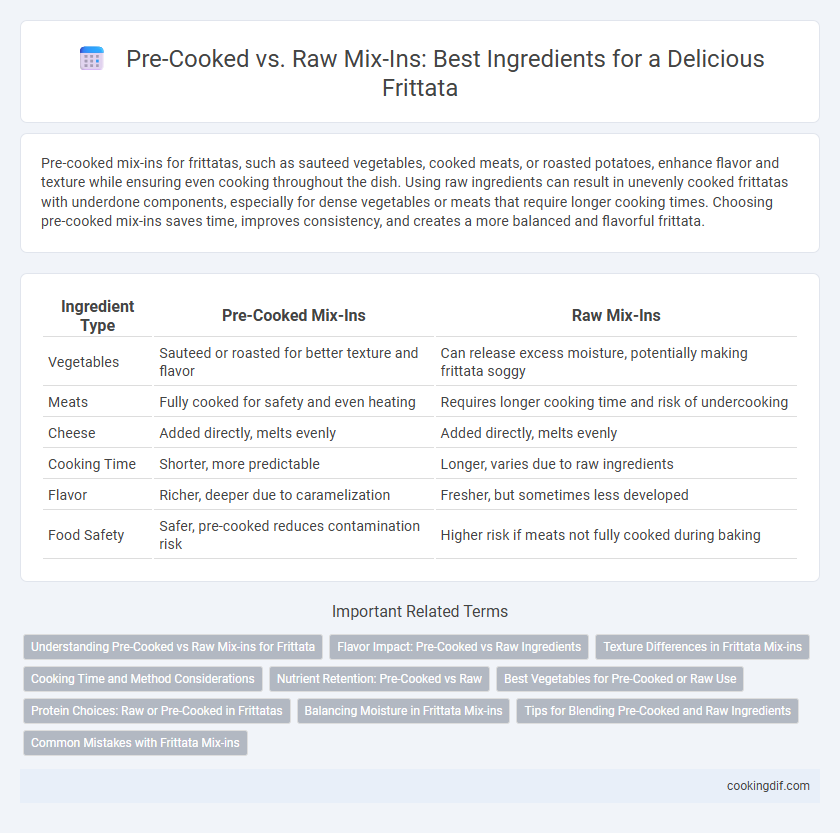Pre-cooked mix-ins for frittatas, such as sauteed vegetables, cooked meats, or roasted potatoes, enhance flavor and texture while ensuring even cooking throughout the dish. Using raw ingredients can result in unevenly cooked frittatas with underdone components, especially for dense vegetables or meats that require longer cooking times. Choosing pre-cooked mix-ins saves time, improves consistency, and creates a more balanced and flavorful frittata.
Table of Comparison
| Ingredient Type | Pre-Cooked Mix-Ins | Raw Mix-Ins |
|---|---|---|
| Vegetables | Sauteed or roasted for better texture and flavor | Can release excess moisture, potentially making frittata soggy |
| Meats | Fully cooked for safety and even heating | Requires longer cooking time and risk of undercooking |
| Cheese | Added directly, melts evenly | Added directly, melts evenly |
| Cooking Time | Shorter, more predictable | Longer, varies due to raw ingredients |
| Flavor | Richer, deeper due to caramelization | Fresher, but sometimes less developed |
| Food Safety | Safer, pre-cooked reduces contamination risk | Higher risk if meats not fully cooked during baking |
Understanding Pre-Cooked vs Raw Mix-ins for Frittata
Using pre-cooked mix-ins in a frittata ensures even cooking and prevents excess moisture from diluting the eggs, which maintains a firm and tender texture. Raw mix-ins require careful timing and smaller, finely chopped pieces to cook thoroughly within the baking time, ensuring they become tender without leaving hardness or a raw taste. Selecting the appropriate preparation method for vegetables, meats, and cheeses optimizes flavor integration and overall frittata consistency.
Flavor Impact: Pre-Cooked vs Raw Ingredients
Pre-cooked mix-ins in a frittata, such as sauteed vegetables or browned meats, intensify flavor by caramelizing sugars and developing savory notes, resulting in a richer taste profile. Raw ingredients like fresh spinach or diced tomatoes release moisture during cooking, which can dilute flavors and create a softer texture, impacting the frittata's overall flavor complexity. Choosing pre-cooked ingredients enhances depth and savoriness, while raw mix-ins contribute freshness but may require careful moisture management to maintain optimal flavor balance.
Texture Differences in Frittata Mix-ins
Pre-cooked mix-ins in a frittata, such as sauteed vegetables or browned meats, contribute a tender texture and deeper, caramelized flavors that meld seamlessly during baking. Raw mix-ins retain more moisture and a firmer bite, resulting in contrasting textures and a fresher taste profile. Choosing between pre-cooked and raw ingredients significantly affects the overall mouthfeel and cooking time of the frittata.
Cooking Time and Method Considerations
Pre-cooked mix-ins for frittatas, such as sauteed vegetables or cooked meats, reduce overall cooking time and ensure even heat distribution, preventing undercooked or overcooked ingredients. Raw mix-ins require longer cooking periods and careful monitoring to ensure they soften adequately and fully cook within the frittata, often necessitating pre-sauteing or par-cooking techniques to achieve the right texture. Understanding these differences allows for precise adjustments in cooking methods, optimizing texture and flavor while maintaining proper food safety and doneness.
Nutrient Retention: Pre-Cooked vs Raw
Using pre-cooked mix-ins in a frittata can lead to diminished nutrient retention, especially heat-sensitive vitamins like vitamin C and folate, compared to raw ingredients. Raw vegetables retain more antioxidants and water-soluble nutrients during cooking, preserving their nutritional profile better. Balancing mix-in choices allows for enhanced flavor complexity while optimizing vitamin and mineral content in frittatas.
Best Vegetables for Pre-Cooked or Raw Use
Best vegetables for pre-cooked mix-ins in frittatas include mushrooms, spinach, and onions, as cooking them beforehand enhances their flavor and moisture release. Raw vegetables like bell peppers, zucchini, and cherry tomatoes retain their crisp texture and bright taste when added directly to the egg mixture. Selecting between pre-cooked or raw depends on desired texture and cooking time, ensuring a balanced and flavorful frittata.
Protein Choices: Raw or Pre-Cooked in Frittatas
Choosing between raw and pre-cooked proteins in frittatas affects texture and cooking time significantly. Raw proteins like diced chicken or sausage require thorough cooking within the frittata, ensuring juicy, tender bites, while pre-cooked options such as ham or smoked salmon add convenience and controlled flavor intensity. Balancing moisture content and cooking duration is essential when combining both to achieve a perfectly set, flavorful frittata.
Balancing Moisture in Frittata Mix-ins
Balancing moisture in frittata mix-ins is crucial for achieving a perfect texture and even cooking. Using pre-cooked ingredients like sauteed vegetables or browned meats reduces excess water release, preventing a soggy frittata and allowing flavors to concentrate. Raw mix-ins, such as fresh tomatoes or zucchini, require careful handling to minimize moisture by draining or salting before adding to the egg mixture, ensuring the frittata sets properly without becoming watery.
Tips for Blending Pre-Cooked and Raw Ingredients
Pre-cooked mix-ins such as sauteed vegetables or cooked meats should be drained and cooled to prevent excess moisture from making the frittata soggy. Raw ingredients like spinach or tomatoes require even chopping to ensure quick, even cooking when combined with eggs. Balance moisture levels by incorporating cheese or breadcrumbs to absorb any liquid released from raw or pre-cooked components, maintaining a perfect texture.
Common Mistakes with Frittata Mix-ins
Adding raw mix-ins such as raw potatoes or dense vegetables often results in uneven cooking and undercooked textures in a frittata. Using pre-cooked ingredients like sauteed mushrooms, caramelized onions, or steamed spinach ensures even heat distribution and enhances flavor integration. Avoiding the mistake of mixing wet or watery raw vegetables prevents excess moisture that can make the frittata soggy and difficult to set.
Pre-cooked vs Raw mix-ins for Frittata ingredients Infographic

 cookingdif.com
cookingdif.com